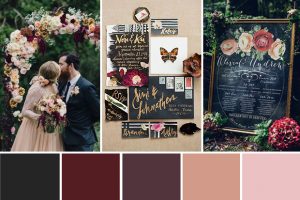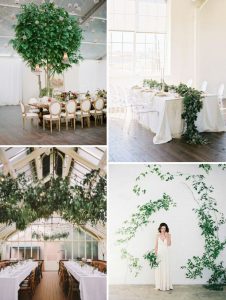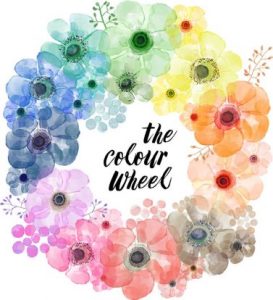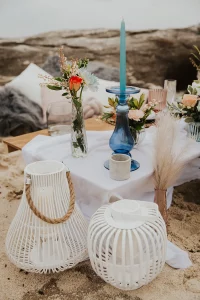Picking your wedding palette isn’t exactly as easy as choosing your two favourite colours and making them the foundation for every wedding detail. Get started with our guide for selecting your wedding hues.
1. Get Inspired by Your Setting
First things first: location. Have a colour palette in mind as you start your venue search. Think about what colours you’d like to use, and whether you’d want to prioritise finding the perfect venue or having your perfect colour palette. If you find a venue that you love, but it doesn’t work with your colours, you’ll want to switch up a hue or two so you don’t bust your budget on trying to cover up or distract from the fact that it doesn’t match. Venues like converted warehouses, lofts and tents are all blank slates, meaning you can really add as much or as little as you want to carry out your vision for colour and style. If you’ve already found the perfect venue, use the space to help you come up with your colour scheme. The colours of your reception space and its surroundings, whether it’s the vintage Persian rug in the dining room or the view of the ocean, can spark an idea. And that way, you won’t have to work against a clashing colour palette and your colours will enhance what you love about your venue.
Dark Woodland Romance Colour palette
2. Keep Your Priorities In Mind
While the venue is usually the biggest choice you have to make in your wedding planning, sometimes there are other details to consider that might come before choosing your colours too. If you’ve always dreamed of having your wedding overflowing with purple dendrobium orchids, then you should use that as a starting point for your palette, instead of trying to figure out a way to work it in later. You don’t want to choose a colour scheme only to find that a must-have, like your grandmother’s ivory table runner, looks out of place or may get lost in the décor rather than standing out like you want it to.
3. Think Seasonally
Just like your wardrobe, your wedding colour scheme can be inspired by the time of year you’re saying “I do.” Think about the shade you want to use to bring out the season in your colour palette. Rosy pink is perfect for spring, while a brighter coral is a summer staple. For fall, a rich fuchsia pairs well with other jewel tones, and blush and silver are a pretty wintry combo. Don’t shy away from colours you love though just because of seasonal colour “rules,” which have pretty much gone the way of wearing white after Labor Day. Light pastels and barely there hues, like buff, can work for a fall or winter wedding The trick is to concentrate on texture, and maybe even bring in a stronger accent colour.
4. Set the Mood
Your wedding colours can also help create a vibe for your wedding day. If you’re going for a lot of drama, then a dark or jewel tone palette, like ruby red and black or emerald and gold, is a better choice than, say, light pastels. Think about the style and atmosphere you want to have, whether it’s relaxed or nostalgic, and what colours put you in that mind-set.
5. Look to What You Love
The colours that inspire your home décor are ones you know you can live with for a long time (and it’s an extra perk that leftover items like Moroccan lanterns will get used after your wedding day). Open your closet: What colour clothes and accessories are you drawn to? Use that as a starting point for choosing your wedding hues.
6. Do Your Research
Magazines, art galleries and friends’ weddings are all great sources for inspiration. While you wouldn’t want to choose a colour combo just because it’s on trend, looking towards art and design may help you see colours you already love in a new way.
7. Consult the Colour Wheel
You don’t need a degree from art school to pick your palette, but there are some basic principles to follow. Typically, colours that go well together are ones that are opposites because they pair a cool and warm (examples include orange and sky blue and turquoise and coral). Other colour pairings that work are “neighbours”—they’re similar to each other and share a primary colour (think: sunshine yellow and melon orange or fuchsia and blush). A classic way to build your colour palette is by pairing a bright, saturated colour with a neutral, like violet and grey or blush and gold
.
8. Don’t Overthink It
It’s easy to get caught up in the idea that you have to have a strict wedding colour palette. If you’re early in the planning process, you’ll probably get asked, “What are your colours?” a lot by friends and family, and that can put pressure on you to pick the “right” hues. But colour doesn’t have to play the major role that it’s sometimes made out to be. While your palette will inform a lot of your wedding decisions, like your flowers and your bridesmaid dresses, you should use it as a guideline instead of a rule. Not every part of your wedding has to match perfectly, so don’t stress on having every detail colour-coded just right. Instead, think of your wedding planning in terms of style, formality, texture and mood, in addition to colour.
8. NPM Events are here to help
We love organising weddings and enjoy seeing our brides and grooms ideas and inspiration come to life.We can assist you from Florals, Centrepieces, Ceremonies, Floral ceiling Installations and much more! We love pushing the boundaries and creating your dream.
To arrange your FREE consultation, contact us today!





